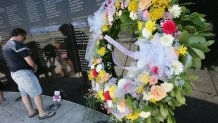The partially reconstructed wreckage of the Trans World Airlines Flight 800 is set to be decommissioned after years of use for federal investigative trainings, NTSB officials announced on Monday.
TWA 800 Flight exploded shortly after takeoff on July 17, 1996 from John F. Kennedy Airport, killing 230 onboard and crashing into the Atlantic Ocean. The Paris-bound jet had just left the airport when it exploded off Long Island, setting off a massive FBI probe amidst fears that a bomb or missile was to blame.
The following four-year investigation was one of the most exhaustive in U.S. aviation history. Federal aviation experts later determined the crash probably resulted from an electrical spark that set off fumes in an empty fuel tank.
"From that investigation we issued safety recommendations that fundamentally changed the way aircraft are designed," NTSB Managing Director Sharon Byson said in a statement released Monday. "The investigation also led to a memorandum of understanding between the FBI and the NTSB regarding investigations of accidents resulting from intentional acts as well as evidence collection and preservation."
Get Tri-state area news and weather forecasts to your inbox. Sign up for NBC New York newsletters.
In the following years, the NTSB used the reconstruction of the planes wreckage for investigation training courses for almost 20 years. The NTSB announced the upcoming decommission as its lease on the 30,000 square foot hangar in Virginia nears expiration.
The federal safety agency plans to complete 3-D scanning and drone imaging of the wreckage before decommissioning the plane. Use of the reconstruction will stop in July before its scanned for historical purposes.
News
"When the NTSB moved the reconstruction to the Training Center, it did so with the stipulation that it would be used solely as a training resource and never as an exhibit or public display. To honor this agreement made with the families of the victims of TWA Flight 800, the NTSB will work closely with a federal government contractor to dismantle the reconstruction and destroy the wreckage," the NTSB release stated.
In 2014, the NTSB turned down the requests of former investigators to reopen the probe into the 1996 crash, saying new evidence pointed to an often-discounted theory that a missile strike may have downed the jumbo jet.
The NTSB said that the group’s analysis of radar evidence to bolster their claims was flawed; that no evidence of a warhead was found; and that the debris field suggests the plane came apart mid-air after an ignition in the center wing fuel tank.




